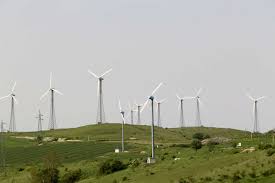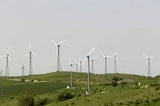Wind Power
SKU:
€0.00
Unavailable
per item
https://www.siemensgamesa.com/en-int
https://www.enercon.de/en/home/
Why Wind
It’s clean. Wind-generated electricity does not pollute the air, water or soil, does not create acid rain, radioactive waste, or contribute to global warming, and does not consume the large amounts of water needed by other energy sources.
It’s renewable. Wind is the result of daily solar radiation. Unlike fossil fuels, the supply of wind power is unlimited and cannot be depleted. Wind resources are widely distributed throughout the United States.It’s economical. The price of electricity generated by new wind power plants is competitive with the price of electricity from new fossil fuel plants. The price of wind is not subject to fuel price increases, supply disruptions, or stricter limits on pollution. The price of fuel (wind) is free. In addition, if governments place a price on the emission of carbon dioxide (CO₂), wind will not be subject to this added cost that will apply to fossil fuel-generated electricity.
It’s good for rural communities. Wind power diversifies the economies of rural communities, adds to the property tax base, and creates highly skilled jobs in construction, and operations and maintenance. Wind power supports agriculture by providing ongoing income for farming and ranching families even as the land used for wind turbines continues to be used for grazing and farmland. Developing renewable sources of electricity means putting our energy dollars back into the local economy.
It’s compatible with many other land uses. The wind turbines and related facilities at a utility-scale wind power plant typically occupy less than 2% of total project land area. The vast majority of land remains free to use in other ways, including ranching, farming, mineral development, hunting, recreation, and many other activities.
It’s fast to install. Large utility-scale wind power plants are routinely built in less than one year. By contrast, most other power plants take years to construct.
At the end of 2009, there were over 35,000 megawatts (MW) of wind power plants installed in the U.S. That is enough to power over 9 million homes worldwide. 159,000 MW have been installed. Wind power installations in the U.S. grew at an average annual rate of 39% from 2004 through 2009. Worldwide the growth rate in 2009 was over 31%. These growth rates make wind one of the world’s fastest growing power generation technologies. The state of Iowa now generates over 17% of its electricity from wind, and the state of Texas more than 6%. Internationally, Denmark generates more than 20% of its electricity from wind, Germany generates approximately 7%, and Spain generates in excess of 12%
https://www.enercon.de/en/home/
Why Wind
It’s clean. Wind-generated electricity does not pollute the air, water or soil, does not create acid rain, radioactive waste, or contribute to global warming, and does not consume the large amounts of water needed by other energy sources.
It’s renewable. Wind is the result of daily solar radiation. Unlike fossil fuels, the supply of wind power is unlimited and cannot be depleted. Wind resources are widely distributed throughout the United States.It’s economical. The price of electricity generated by new wind power plants is competitive with the price of electricity from new fossil fuel plants. The price of wind is not subject to fuel price increases, supply disruptions, or stricter limits on pollution. The price of fuel (wind) is free. In addition, if governments place a price on the emission of carbon dioxide (CO₂), wind will not be subject to this added cost that will apply to fossil fuel-generated electricity.
It’s good for rural communities. Wind power diversifies the economies of rural communities, adds to the property tax base, and creates highly skilled jobs in construction, and operations and maintenance. Wind power supports agriculture by providing ongoing income for farming and ranching families even as the land used for wind turbines continues to be used for grazing and farmland. Developing renewable sources of electricity means putting our energy dollars back into the local economy.
It’s compatible with many other land uses. The wind turbines and related facilities at a utility-scale wind power plant typically occupy less than 2% of total project land area. The vast majority of land remains free to use in other ways, including ranching, farming, mineral development, hunting, recreation, and many other activities.
It’s fast to install. Large utility-scale wind power plants are routinely built in less than one year. By contrast, most other power plants take years to construct.
At the end of 2009, there were over 35,000 megawatts (MW) of wind power plants installed in the U.S. That is enough to power over 9 million homes worldwide. 159,000 MW have been installed. Wind power installations in the U.S. grew at an average annual rate of 39% from 2004 through 2009. Worldwide the growth rate in 2009 was over 31%. These growth rates make wind one of the world’s fastest growing power generation technologies. The state of Iowa now generates over 17% of its electricity from wind, and the state of Texas more than 6%. Internationally, Denmark generates more than 20% of its electricity from wind, Germany generates approximately 7%, and Spain generates in excess of 12%




